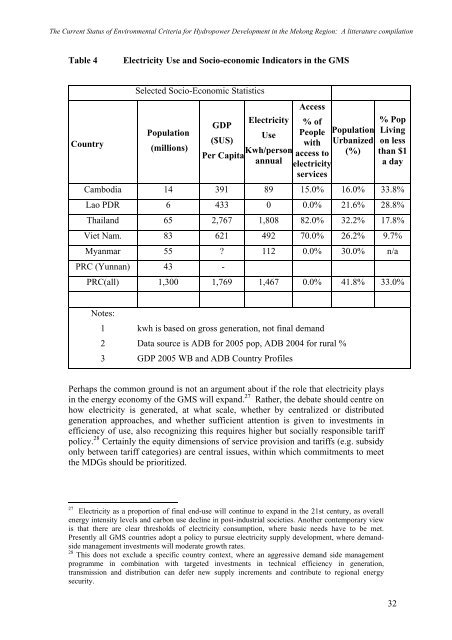Environmental Criteria for Hydropower in the Mekong Region - WWF
Environmental Criteria for Hydropower in the Mekong Region - WWF
Environmental Criteria for Hydropower in the Mekong Region - WWF
You also want an ePaper? Increase the reach of your titles
YUMPU automatically turns print PDFs into web optimized ePapers that Google loves.
The Current Status of <strong>Environmental</strong> <strong>Criteria</strong> <strong>for</strong> <strong>Hydropower</strong> Development <strong>in</strong> <strong>the</strong> <strong>Mekong</strong> <strong>Region</strong>: A litterature compilation<br />
Table 4 Electricity Use and Socio-economic Indicators <strong>in</strong> <strong>the</strong> GMS<br />
Country<br />
Selected Socio-Economic Statistics<br />
Population<br />
(millions)<br />
Access<br />
Electricity<br />
GDP<br />
% of<br />
% Pop<br />
Use People Population Liv<strong>in</strong>g<br />
($US)<br />
with Urbanized on less<br />
Kwh/person<br />
Per Capita<br />
access to (%) than $1<br />
annual electricity<br />
a day<br />
services<br />
Cambodia 14 391 89 15.0% 16.0% 33.8%<br />
Lao PDR 6 433 0 0.0% 21.6% 28.8%<br />
Thailand 65 2,767 1,808 82.0% 32.2% 17.8%<br />
Viet Nam. 83 621 492 70.0% 26.2% 9.7%<br />
Myanmar 55 ? 112 0.0% 30.0% n/a<br />
PRC (Yunnan) 43 -<br />
PRC(all) 1,300 1,769 1,467 0.0% 41.8% 33.0%<br />
Notes:<br />
1 kwh is based on gross generation, not f<strong>in</strong>al demand<br />
2 Data source is ADB <strong>for</strong> 2005 pop, ADB 2004 <strong>for</strong> rural %<br />
3 GDP 2005 WB and ADB Country Profiles<br />
Perhaps <strong>the</strong> common ground is not an argument about if <strong>the</strong> role that electricity plays<br />
<strong>in</strong> <strong>the</strong> energy economy of <strong>the</strong> GMS will expand. 27 Ra<strong>the</strong>r, <strong>the</strong> debate should centre on<br />
how electricity is generated, at what scale, whe<strong>the</strong>r by centralized or distributed<br />
generation approaches, and whe<strong>the</strong>r sufficient attention is given to <strong>in</strong>vestments <strong>in</strong><br />
efficiency of use, also recogniz<strong>in</strong>g this requires higher but socially responsible tariff<br />
policy. 28 Certa<strong>in</strong>ly <strong>the</strong> equity dimensions of service provision and tariffs (e.g. subsidy<br />
only between tariff categories) are central issues, with<strong>in</strong> which commitments to meet<br />
<strong>the</strong> MDGs should be prioritized.<br />
27 Electricity as a proportion of f<strong>in</strong>al end-use will cont<strong>in</strong>ue to expand <strong>in</strong> <strong>the</strong> 21st century, as overall<br />
energy <strong>in</strong>tensity levels and carbon use decl<strong>in</strong>e <strong>in</strong> post-<strong>in</strong>dustrial societies. Ano<strong>the</strong>r contemporary view<br />
is that <strong>the</strong>re are clear thresholds of electricity consumption, where basic needs have to be met.<br />
Presently all GMS countries adopt a policy to pursue electricity supply development, where demandside<br />
management <strong>in</strong>vestments will moderate growth rates.<br />
28 This does not exclude a specific country context, where an aggressive demand side management<br />
programme <strong>in</strong> comb<strong>in</strong>ation with targeted <strong>in</strong>vestments <strong>in</strong> technical efficiency <strong>in</strong> generation,<br />
transmission and distribution can defer new supply <strong>in</strong>crements and contribute to regional energy<br />
security.<br />
32

















